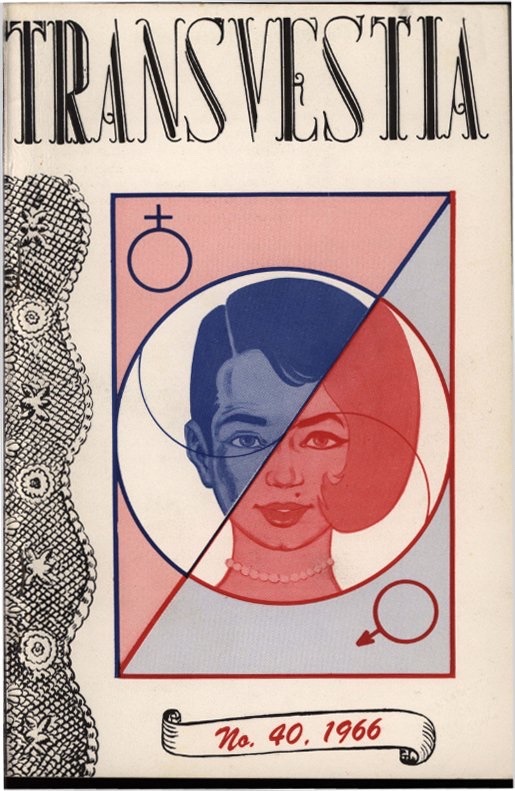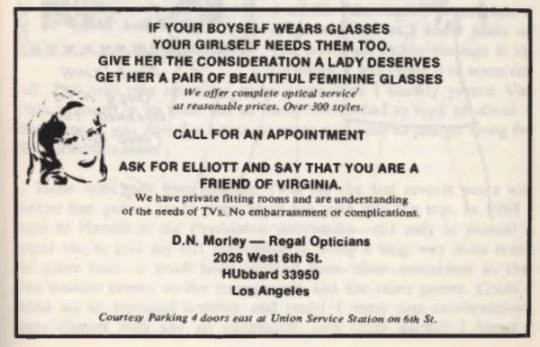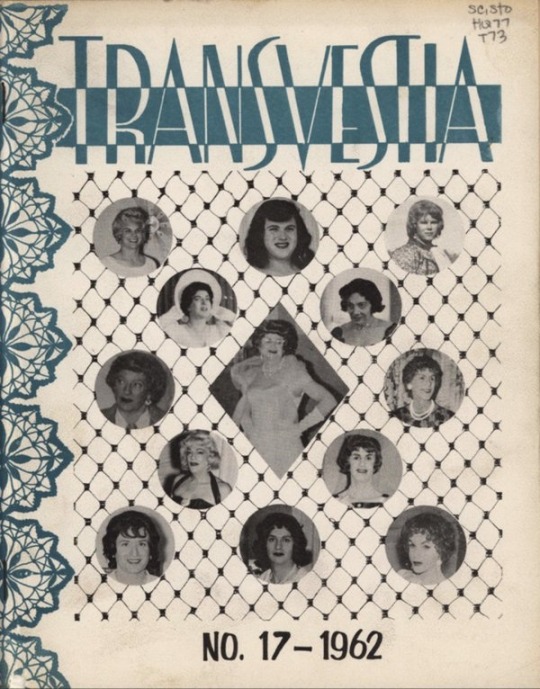#transvestia tv fiction
Explore tagged Tumblr posts
Photo
But remember folks, trans is a brand new thing meant to poison the minds of children

Published in “Transvestia” magazine #90 (1977) and reedited in the book “Birth of Barbara”, by Sandy Thomas (Transvestia TV Fiction #14), published by herself.
23K notes
·
View notes
Text
There Was an Underground Magazine for Transgender Women in the 1960s! Transvestia's Archives Provide a Window onto a Hidden World
— June 22, 2023 | Kirstin Butler & Casa Susanna | Article | American Experience

The cover of the August 1966 issue of Transvestia magazine.
In the first month of a new decade, a Los Angeles chemist named Virginia Prince mailed out the inaugural issue of a magazine. It was, as the title page of the January 1960 edition of Transvestia states, a privately printed journal “with three objectives: to provide EXPRESSION for those interested in the subjects of exotic and unusual dress and fashion; to provide INFORMATION to those who, through ignorance, condemn that which they do not understand,” and, finally, “to provide EDUCATION for those who see evil where none exists.” With these oblique statements, Prince launched what would become the first long-running periodical for male-to-female crossdressers and transgender women in the United States.
Over its 25-year print run, Transvestia grew from 25 initial subscribers to several hundred distributed across the U.S. Most readers received their bi-monthly issues through the mail, though after 1963 the magazine could also be found in alternative and adult bookstores and newsstands in major American cities. Prince was the magazine’s driving force and served as editor until 1979, but Transvestia’s contents were as much by its readers as for them. Subscribers submitted life histories, letters, editorials, book reviews and photographs of themselves. They had their own jargon: “TV” for transvestite, “GG” for “genetic girls,” “brother” for their male identities and the “girl-within,” to refer to their feminine selves; some readers also used “femmepersonator” or “FP” for short. Prince also reprinted medical papers on topics such as gender identity and the psychology of cross-dressing.
Each issue typically ran around 80 pages, with several dedicated to advertisements for various goods—self-published books, custom undergarments and wigs—and services such as electrolysis and makeup consultation. “Perhaps there are no good stores in your town. Perhaps you are too well known,” offered one advertisement for a personal shopper. “Perhaps you need an unusual size and would be embarrassed to ask for it. Whatever the reason, I can help.” Every issue also contained a “Person to Person” section where subscribers could connect with one another. “Lifelong TV, married, 34, scientist, welcomes all correspondence with all TV’s foreign or domestic,” reads a listing by Barbara, a reader from southern New England, in the December 1965 issue.

An optician’s ad in Transvestia’s October 1969 Issue.
Transvestia was an outlet for creative writing as well. A piece of fiction in the magazine’s first issue told the story of a married couple enjoying a night out, both husband and wife dressed in traditionally feminine attire: “The sound of my high heels matching hers, the sight of my frock swirling beside hers, made us feel as one…sensing the fragrance of the real woman so close to me, the distinction between ‘man’ and ‘woman’ vanished like smoke in a high wind.” Prince herself contributed a poem to that issue, composing on a theme that would recur in many other editions of the magazine—the relief experienced upon transforming from masculine to feminine archetypal expectations and presentation.

Poems in the January 1960 and March 1961 issues of Transvestia.
In fact, several subjects appeared with a great deal of regularity throughout Transvestia’s pages. Dr. R.S. Hill, a professor at Concordia University, authored a seminal study of the magazine as his dissertation. Reflecting on Transvestia’s most oft-recurring content, Dr. Hill wrote, “The letters and histories endlessly elaborated on the same themes and topics: theorizing the causes of their condition; crossdressing for the first time; overcoming obstacles to free expression; dealing with guilt, fear, or loneliness; disclosing to or hiding from parents, wives, and children; venturing out in public; passing successfully as women without public detection; describing articles of clothing, wardrobes, and bodily measurements; and sharing fashion and make-up advice.”
Through the magazine, Transvestia readers forged a group consciousness, united not just by mutual interests but also for their common demography: The majority of subscribers were white, middle-to-professional-class, and considered themselves heterosexual. Most were married and had children. Some spoke of cross-dressing as just a relaxing “hobby” they occasionally enjoyed. But a substantial number would come to identify as women over the course of the journal’s publication, including Prince herself as well as contributing editor Susanna Valenti. Prince wrote about that decision in her final issue as editor in 1979, saying, “I figured that since I had learned pretty much all I needed to know about being a man in this world, that I might just as well devote the rest of my life to exploring the other side of my own humanity…That was in June of 1968 and I have lived as Virginia ever since.”
All of the magazine’s readers agreed that the practice of cross-dressing allowed them to access their most vibrant selves. “I have been married, have fathered five children, and am about to become a Grandpa any day now,” said the magazine’s 1962 covergirl Eileen in an accompanying personal history. “The men I work with are all hairy chested so-and-so types, and have accepted me into their ranks without question. Yet, when I rush home from the office and enter my own world of delight, that is when I truly live.”

Transvestia subscriber Eileen graced the cover of the magazine's August 1962 Issue.
The Publisher
Having been through a great deal of pain, fear, guilt, loneliness and frustration in my life I wanted to help others to avoid or conquer these feelings. My tool for doing this has been Transvestia.” — Virginia Prince, Transvestia, Vol. 3 No. 16, August 1962
Born in 1912, Virginia Prince was the highly opinionated, often irascible godmother of Transvestia’s print pages and its extended real-life network. After launching the magazine, she also founded a national sorority for other crossdressers in 1962 called Phi Pi Epsilon—or FPE, which also stood for Full Personality Expression. This later became Tri-Ess, or the Society for the Second Self, an international crossdressing organization that still exists to this day. Prince frequently gave interviews to American and international media and liaised with medical professionals about the practice of cross-dressing.

The magazine’s “Person to Person” section was restricted to FPE sorority members to ensure correspondents’ safety.
Prince’s primary goal was to destigmatize cross-dressing; and she utilized the magazine as well as FPE to create a conservative bulwark against other, competing forms of transgender life and community in the United States in the 1960s. “Prince wanted to socialize individual ‘deviance,’” said Dr. Hill, “to place transvestism within a group context, domesticate it, and normalize it by promoting the radical idea that transvestites were not immoral, sexual deviants but rather normal, respectable citizens with only a harmless gender variation.” Even the name of Prince’s regular column in the magazine, “Virgin Views,” was part of her plan to de-eroticize a lifestyle that included cross-dressing by linking it to connotations of purity.
Already within a year of Transvestia’s genesis, Prince had assumed the role of self-appointed moral arbiter. “We must keep our own house clean and above reproach,” she asserted in the magazine’s March 1961 issue. In a repressive Cold War context where heteronormative standards reigned, that meant distancing cross-dressing from other gender and sexual subcultures: “We all know that the world confuses transvestism and homosexuality and when there is a campaign against the latter we are caught in the crossfire.” Prince asked readers to police themselves and each other, saying, “you come into the future of the magazine, not just by way of financial support and contributions of material, but by being a watchdog too.”

Prince’s column in the December 1965 issue included her portrait.
As part of her desire to domesticate transvestism, Prince also sought out and published writings by transvestites’ female partners. Some were tender—thus supporting Prince’s respectability campaign—as in an account from a wife about her husband’s transformation to “Betty Lynn, the Blonde Bombshell.” “I can’t understand why anyone wouldn’t want another dimension to their love,” wrote Fran. Still, the majority of Transvestia readers spoke of fraught negotiations around their cross-dressing, sometimes ending in the dissolution of marriage.
The narrative Prince espoused through Transvestia initially held that the goal of transvestism should be an exercised balance of masculine and feminine identities, with each having its own separate opportunity for expression. “[T]ry to employ perspective in seeing FemmePersonation as an adjunct to your masculine personality, not a substitute for it,” she suggested in her August 1962 “Virgin Views” column. “Transvestia does not exist for the purpose of impairing or destroying the masculine but rather to allow those who are aware of their feminine side to extract the full benefits from it. We can experience some of the feminine side of life, express part of our personality that way, and be better persons and citizens for it IF we…keep the whole matter in balance and under control.”
She advised against medical interventions such as hormone therapy and what was then known as sex reassignment surgery, saying, in 1965, “I realized that surgery would be a form of suicide not only for my masculine self but for Virginia too since it would cut the ground (as well as other things) out from under her…being a woman some of the time is wonderful, having to be one all the time would not be half as great as it seems to be from a distance.” As Dr. Hill writes, “‘transsexuality’ is everywhere in Transvestia as a category against which the ‘true transvestites’ defined themselves.”

Transvestia’s October 1962 cover featured photos of its first two years of cover models—“The composite cover of 12 livin’ dolls.” Prince’s is the largest photo in the center.
Over the coming years, however, Prince’s position would shift from this earlier dichotomous gender model to an identity where one’s masculine and feminine selves were merged into an integrated whole. “[V]ery little in life is tied up hard and fast with the fact that one is male or female,” she wrote in the August 1966 issue, adding “that the ideas of man and woman and masculine and feminine are cultural inventions for all their assumed usefulness.” Her views on gender had gradually become more flexible.
By June 1968, Prince had come to a decision to live full-time as a woman. Assembling the magazine, she said later, was what had allowed her to arrive at that turning point. “In trying to help you, my readers, I have learned and grown myself,” she wrote in the magazine’s 100th anniversary issue in 1979, which was largely dedicated to “The Life and Times of Virginia,” her personal history. “I am now a whole person, completely self accepting and at ease…[M]y best hopes and good wishes to all of you—may you, too, find the acceptance and the internal peace that we all need, and with that I say farewell.”
Susanna Says
“But Enough of Philosophising…Let's Gossip!” — “Susanna Says,” Transvestia, Vol. 7 No. 40, August 1966
Where Virginia Prince was Transvestia’s reigning West Coast intellectual, Susanna Valenti, the magazine’s contributing editor, was its East Coast bon vivant. Her regular column, “Susanna Says,” contained social news, fashion tips and advice, all served up with attitude and pointed humor. “I most certainly have particular people in mind whenever I unsheath a journalistic claw,” she wrote in February 1963, in response to what some readers deemed her “cattish remarks.” “Where would the fun be,” she protested, “if people could not see themselves mirrored in the printed page?”
For Valenti, criticism also had a noble purpose. She offered cosmetic and comportment tips—informing her readers about the right ways to walk, how to soften their voices and what pressed powders to wear—because those elements would allow them to more safely present to a world threatening arrest and violence. “Sorry, my friends, to sound so mean,” she demurred in that same column. “[S]omebody has to pour out a bucketful of cold, merciless realism, just to remind ourselves that the world is not entirely made of pretty clouds and blue skies. There’s also mud and hard pavement under our feet.” If being “read”—common community parlance for being discovered while dressed—was the greatest danger, and “passing”successfully as female would ensure their protection, then Valenti would scold Transvestia subscribers into shape.

Virginia included this image of herself and Susanna in Tranvestia’s 100th anniversary Issue.
“[P]resent as smooth an image as possible,” “Susanna Says” advised in 1965. “In some areas there's nothing we can do about—height, skeletal frame, feet, hands, muscles, etc—but in those areas where something can be done, there's just no excuse if we don't at least make an effort.” Valenti spoke at length about her own efforts: wardrobe alterations, dance classes and diets. For her, moral improvement could be achieved by means of aesthetic perfection—and why not enjoy oneself doing it? “The real fun about being a TV,” she proclaimed, “is in the CONSTANT IMPROVING.”

The April 1965 issue continued a feature that spanned several editions called “What Should I Wear?” and contained tutorials on wardrobe color, shape and style, including guides to neckline types and hem lengths.
Like Prince, Valenti had a significant community presence both on and off the page. In the very first issue of Transvestia, she announced that she and her wife Marie were opening a private retreat at their property in the Catskill Mountains catering specifically to Transvestia’s audience; the “Chevalier d’Eon Resort” was named after an 18th-century French crossdressing spy. “Change clothes as many times as you want, stay inside or go out—in short, do as you please and ‘LIVE.’ Even hairdressing help will be available,” promised the announcement. “What more can you ask? This sounds more like fiction than a lot of fiction, but it's real!” Indeed, over the next decade, Marie and Susanna would run what eventually became the eponymous “Casa Susanna,” which became the East Coast hub for crossdressers and a burgeoning transgender community.
Valenti, who had adopted Prince’s script against transitioning, also came to change her position with the changing times. She announced her own decision to live full-time as a woman in Tranvestia’s October 1969 issue. “I’ve ceased feeling that fabulous thrill of the change itself,” Valenti said of her part-time transitions back and forth from Susanna to her male identity. “It’s only fabulous in one direction: from HIM to HER. But the reverse from HER to HIM, is becoming more and more painful. It actually depresses me… To be ‘her’ is quite different. Energy seems to flow into me from all directions, and no matter what activity I engage in, I never seem to tire…I cannot speak of thrills, but of a peace and contentment that I find nowhere else.”

Susanna Valenti announced a momentous personal decision in her column for the October 1969 Issue.
Still, her final words in the magazine were more equivocal. A decade later, in 1979, Valenti reprised her column once more at Prince’s request for the centennial issue. “One hundred years! Or is it one hundred issues of TVia?” Valenti mused. “It really seems like a century ago we started groping in the confusion of our lives for a truth and a self-definition. We followed the same pattern that modern youth seems to have found, the eternal question of ‘who am I’?” Then she took stock of the gains Transvestia had won for her community, saying, “We seem to have moved forward to a certain extent. A good number of people, many more than there were one hundred issues ago, know about us. The moral ‘liberation’ of our times seems to have helped somewhat, too.
“But,” she concluded, “we ask ourselves, have we really become liberated? Have we really become understood? Accepted?”
#American Experience#Transgender Women#Underground Magazine#Transvestia's Archives#Hidden World 🌎#Kirstin Butler & Casa Susanna#Publisher#Philosophising#Susanna Valenti
17 notes
·
View notes
Photo

Published in “Transvestia” magazine #66 (1971) and reedited in the book “My Pink Mirror”, by Sandy Thomas (Transvestia Fiction Classics #3), published by herself.
314 notes
·
View notes
Photo

Published in “Transvestia” magazine #10 (August 1961) and reedited in the book “Charm School”, by Cathy (Transvestia TV Fiction #12), published by Sandy Thomas.
291 notes
·
View notes
Photo

Published in “Transvestia” magazine #19 (February 1963) and reedited in the book “Acceptance”, by Dee Raymond (Transvestia TV Fiction #11), published by Sandy Thomas.
179 notes
·
View notes
Photo

“The Sisters”, by Tecla, originally published in “Transvestia” magazine #37 (February 1966) and reedited in the book “Fashion Model” by Erna (Transvestia TV Fiction #10), published by Sandy Thomas.
106 notes
·
View notes
Photo

Published in “Transvestia” magazine #90 (1977) and reedited in the book “Birth of Barbara”, by Sandy Thomas (Transvestia TV Fiction #14), published by herself.
23K notes
·
View notes